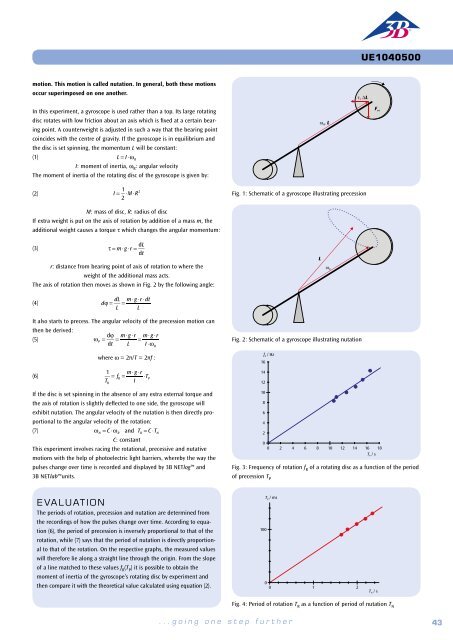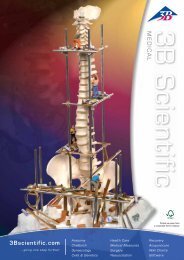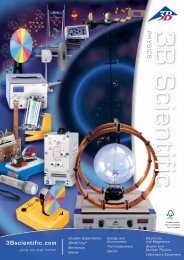3B Scientific - Physics & Engineering Experiments
3B Scientific - Physics & Engineering Experiments
3B Scientific - Physics & Engineering Experiments
You also want an ePaper? Increase the reach of your titles
YUMPU automatically turns print PDFs into web optimized ePapers that Google loves.
UE1050101<br />
Mechanics / Oscillations<br />
Harmonic Oscillation of a<br />
String Pendulum<br />
UE1050101<br />
BASIC PRINCIPLES<br />
A string pendulum with a bob of mass m and a length L will exhibit<br />
simple harmonic oscillation about its rest point as long as the angle of<br />
deflection is not too great. The period T, i.e. the time it takes for the<br />
pendulum to swing from one end of its motion to the other end and<br />
back, is dependent solely on the length of the pendulum L and not on<br />
the mass m.<br />
EVALUATION<br />
The measurements are plotted on a graph of T against L and another<br />
one of T against m. These graphs will show that the period of oscillation<br />
depends on the pendulum’s length and not on the mass of the<br />
bob, as expected.<br />
If the pendulum is deflected from its rest position by an angle ϕ, the restoring<br />
force is as follows:<br />
(1a) F 1<br />
= −m ⋅ g ⋅ sinϕ .<br />
For small angles ϕ, this closely approximates to the following:<br />
T / s<br />
2<br />
(1b)<br />
F 1<br />
= − m ⋅ g ⋅ϕ<br />
The moment of inertia of the accelerated mass is given by<br />
1<br />
(2)<br />
F 2<br />
= m ⋅L ⋅ !!ϕ<br />
OBJECTIVE<br />
Measuring the period of oscillation of a string pendulum with<br />
bobs of various masses<br />
Both these forces are equal, thus the result is equivalent for the equation of<br />
motion for simple harmonic oscillation:<br />
(3)<br />
!!ϕ + g L ⋅ϕ = 0<br />
For the period of oscillation T the following applies:<br />
0<br />
0 50 100<br />
L / cm<br />
Fig. 1: Period of oscillation T as a function of the pendulum length L<br />
E X PERIMEN T<br />
PROCEDURE<br />
• Measure the period of oscillation T of<br />
a string pendulum as a function of the<br />
length of the pendulum L.<br />
SUMMARY<br />
The period of oscillation T for a string pendulum is dependent on the length of the pendulum L, but<br />
does not depend on the mass of the bob m. This is to be verified by a series of measurements in which<br />
the period of oscillation of such a pendulum is measured by means of a photoelectric sensor connected<br />
to a digital counter.<br />
L<br />
(4) T = 2π ⋅ .<br />
g<br />
In this experiment the period of oscillation will be measured for various<br />
lengths of pendulum and masses of bob with the help of a photoelectric<br />
sensor connected to a digital counter. The digital counter’s internal programming<br />
is such that it halts the time measurement after each complete<br />
swing of the pendulum.<br />
T / s<br />
3<br />
2<br />
• Measure the period of oscillation T of<br />
a string pendulum as a function of the<br />
mass of the pendulum bob m.<br />
Required Apparatus<br />
1<br />
• Determine the acceleration due to<br />
gravity g.<br />
Quantity Description Number<br />
1 Set of 4 Pendulum Bobs 1003230<br />
1 Cord for <strong>Experiments</strong> 1001055<br />
1 Tripod Stand 185 mm 1002836<br />
1 Stainless Steel Rod 1500 mm 1002937<br />
0<br />
0 20 40 60 80<br />
m / g<br />
Fig. 2: Period of oscillation T as a function of the pendulum mass m<br />
1 Stainless Steel Rod 100 mm 1002932<br />
1 Clamp with Hook 1002828<br />
2 Universal Clamp 1002830<br />
1 Photo Gate 1000563<br />
1 Digital Counter (230 V, 50/60 Hz) 1001033 or<br />
1<br />
Digital Counter (115 V, 50/60 Hz) 1001032<br />
1 Pocket Measuring Tape, 2 m 1002603<br />
1 Electronic Scale 200 g 1003433<br />
44 <strong>3B</strong> <strong>Scientific</strong>® <strong>Experiments</strong><br />
...going one step further<br />
45















